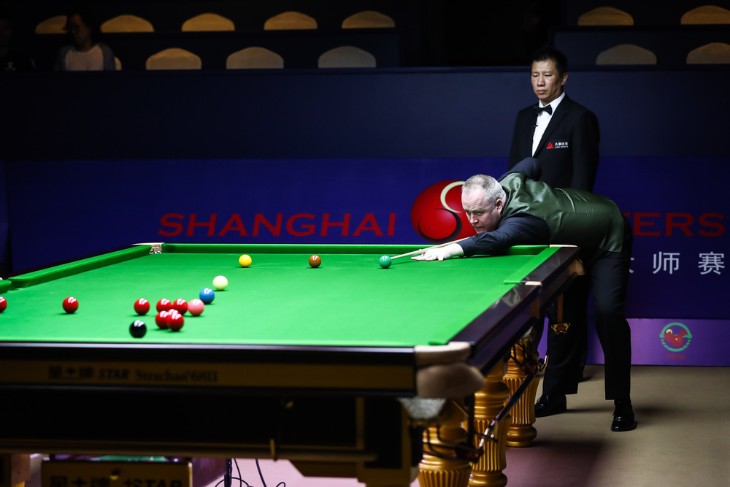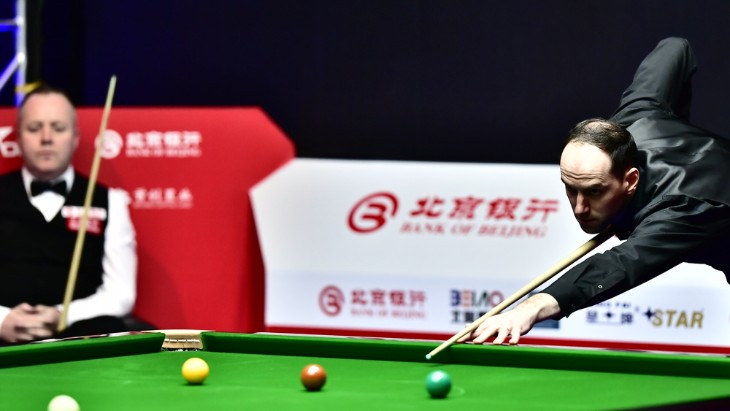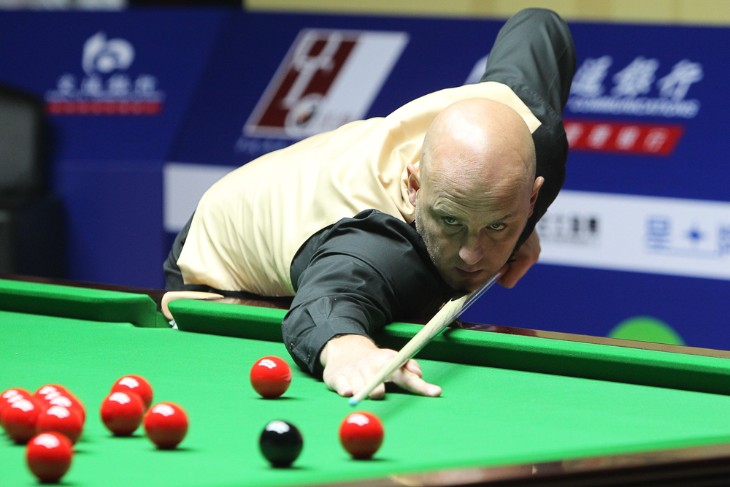Unlocking success in snooker starts with mastering the art of the break. 'How to break in snooker' isn’t just about power—it's a strategic dance of precision, control, and finesse. Let's explore the key steps to shatter expectations and dominate the table.
How to Break in Snooker?
1. Positioning the Cue Ball
Positioning the cue ball correctly is fundamental to the strategic aspect of snooker. It not only determines the starting point but also plays a pivotal role in setting up shots and controlling the game's pace.
- The 'D' Area: In snooker, the 'D' is a semicircular area where the cue ball is placed for the opening break. It's located near the baulk line, and it's the designated spot for starting the game. The cue ball must be placed anywhere within this 'D' area for the break shot.
- Baulk Line: The baulk line is an essential part of positioning the cue ball. It separates the baulk area from the rest of the table. After the break, if the cue ball is potted or if a foul occurs, the cue ball is usually placed within the 'D' or as close to it as possible, in the baulk area, depending on the circumstances of the game.
- Precision and Accuracy: Placing the cue ball precisely within the 'D' area is crucial for a fair start to the game. It requires accuracy and ensures that the break shot is initiated from a standardized position for both players.
- Positional Play: Throughout the game, players strategically position the cue ball for subsequent shots to set up for potting balls or playing safe. This involves using different spin, angles, and positioning techniques to control the cue ball's movement after striking another ball.
- Foul Situations: When a foul occurs, the opponent gets the opportunity to place the cue ball in a position of their choice. They can place it anywhere in the baulk area or within the 'D,' depending on the specific rules being followed.
2. Selecting the Cue
Selecting the right cue in snooker is crucial for achieving precision, control, and comfort during your game and, therefore, one of the most important aspects of the answer to the “how to break in snooker” question. Here are some key factors to consider when choosing a cue:
- Weight and Balance: Cues vary in weight. Some players prefer heavier cues for more power in their shots, while others opt for lighter ones for better control. The cue should feel balanced in your hands, allowing you to execute shots smoothly.
- Cue Length: Standard cues are typically 57-58 inches in length. Taller players might prefer longer cues for better reach, while shorter cues might be more comfortable for others. Experiment with lengths to find what suits you best.
- Tip Quality and Size: The cue tip is crucial for striking the cue ball effectively. Tips vary in size, typically ranging from 9mm to 10mm. A well-maintained, properly shaped, and chalked tip provides better grip on the cue ball, allowing for more accuracy and spin.
- Material and Construction: Cues are made from various materials, such as ash, maple, or other types of wood. Carbon fibre cues are also gaining popularity for their stability and durability. Each material offers different characteristics in terms of feel, stiffness, and response.
- Grip and Feel: The grip of the cue matters for control and comfort. Some cues have a smooth, polished finish, while others might have a textured grip or wrap. Find what feels comfortable in your hand and allows for a steady stroke.
- Personal Preference: Ultimately, cue selection often comes down to personal preference. Trying out different cues and getting a feel for their weight, balance, and how they respond to your strokes is essential. Many players find a cue that feels like an extension of their arm, allowing for greater consistency in their shots.
- Budget Considerations: High-quality cues can be quite expensive, but there are also more affordable options available that offer decent performance. Consider your budget while also keeping an eye out for cues that offer good value for their price.
Before settling on a cue, try out various options to understand what feels most comfortable and enhances your game. Whether it's the weight, balance, grip, or material, finding the cue that suits your style and feels right in your hands can significantly improve your performance on the snooker table.
3. Stance and Grip
Stance and grip are foundational elements in snooker, impacting your ability to deliver accurate shots and maintain consistency throughout the game.
Stance:
- Feet Position: Stand with your feet shoulder-width apart, creating a stable base. The lead foot (the foot closer to the shot) should point toward the intended direction of the shot, while the other foot provides balance and support.
- Body Alignment: Align your body parallel to the shot line, ensuring your chest and hips face the cue ball. Maintain a straight posture with a slight bend at the waist, allowing for a comfortable and natural stroke motion.
- Balance: Distribute your weight evenly on both feet, maintaining balance throughout the shot. Avoid leaning or swaying, as it can affect your accuracy.
- Head Position: Keep your head steady and level, with your eyes focused on the cue ball or the specific target ball. Avoid unnecessary head movement during the stroke to maintain consistency.
Grip:
- Hand Placement: Hold the cue with a relaxed but firm grip. Your bridge hand (the hand that rests on the table) should form a stable bridge to support the cue. The grip hand should be positioned comfortably, with the cue resting in the V-shaped space between your thumb and index finger.
- Cue Placement: Find a grip position that feels natural and allows for a straight, smooth stroke. Avoid gripping the cue too tightly, as it can hinder your ability to deliver a fluid and controlled shot.
- Chalking: Regularly chalk the cue tip to ensure better friction and grip on the cue ball. This helps prevent miscues and allows for more accurate strikes.
- Consistency: Developing a consistent grip and stance is crucial for mastering various shots in snooker. Practice maintaining the same stance and grip for different shot types and positions on the table to improve muscle memory and consistency.
- Comfort and Adaptation: While there are recommended techniques, the best grip and stance for you might involve slight variations based on comfort and personal preference. Experimentation and practice will help you find what works best for your game.

4. Eye on the Object Ball
Keeping your eye on the object ball is a fundamental aspect of cue sports like snooker. The object ball is the ball you're intending to hit with the cue ball. Here’s why focusing on the object ball is crucial and how to do it effectively:
- Aiming Accuracy: Directing your gaze at the object ball helps you align your shot accurately. By focusing on where you want the cue ball to strike the object ball, you enhance your chances of hitting it precisely at the intended spot.
- Visualizing the Shot: Concentrating on the object ball allows you to visualize the trajectory of the shot. You can better anticipate how the object ball will move after being struck by the cue ball, aiding in planning subsequent shots.
- Maintaining Concentration: Keeping your eyes fixed on the object ball helps maintain concentration and focus throughout the shot. It minimizes distractions and helps you stay committed to the shot you’re aiming to execute.
- Improving Cue Ball Control: By focusing on the object ball, you're more likely to strike the cue ball accurately. This accuracy translates into better control over the cue ball’s speed, spin, and direction after impact.
- Staying Still During the Shot: Fixating your gaze on the object ball encourages you to keep your head and body still during the stroke, reducing the likelihood of making errors due to unnecessary movement.
To effectively keep your eye on the object ball:
- Visualize the Shot: Before you get down to take your shot, visualize the path the cue ball will take to hit the object ball where you want it to go.
- Maintain Focus: As you approach the table and line up your shot, keep your eyes on the object ball. Avoid looking at the cue ball or other distractions on the table.
- Follow Through: Continue focusing on the object ball even after striking the cue ball. This ensures you maintain a smooth follow-through and stay committed to the shot.
- Practice and Experience: Regular practice helps develop the ability to focus on the object ball consistently. Over time, this becomes second nature, enhancing your accuracy and overall performance on the table.
Remember, while focusing on the object ball is crucial, it's also essential to strike a balance between focusing on it and being aware of the cue ball's position and movement for better control and adjustments during your shot.
5. Power and Control
In snooker, finding the right balance between power and control is essential for executing shots effectively. Power refers to the force applied to the cue ball, while control involves directing that force accurately. Here's more about power and control in snooker:
Power:
- Shot Strength: Applying the right amount of power to the cue ball is crucial. For breaks, a more forceful strike is necessary to scatter the red balls effectively. However, finesse shots may require a gentler touch.
- Cue Ball Speed: Power determines the speed of the cue ball. Harder strikes result in faster cue ball movement, while lighter shots slow it down. Understanding how power affects speed helps in positioning the cue ball for subsequent shots.
- Scattering Balls: During the break, a powerful stroke aims to spread the red balls across the table, creating opportunities for potting and positioning the cue ball for the next shot.
Control:
- Accuracy: Controlling the direction and impact point of the cue ball on the object ball is crucial. Even with powerful shots, accuracy ensures the desired outcome, whether it's potting a ball or positioning the cue ball for the next shot.
- Spin and English: Applying spin (side or top/bottom) to the cue ball adds finesse and control. Side spin (English) allows for deflection or swerve after contact, while top or bottom spin influences the ball's trajectory post-collision.
- Avoiding Scratches or Fouls: Control prevents unwanted outcomes such as scratching (potting the cue ball) or committing fouls. A controlled stroke reduces errors and helps maintain a strategic advantage.
To master power and control:
- Practice Different Strengths: Experiment with different levels of power during practice to understand how it affects the cue ball's movement and ball interactions on the table.
- Work on Control Techniques: Practice drills that focus on accuracy and control, such as potting balls into specific pockets or positioning the cue ball for precise shots.
- Develop Consistency: Strive for consistency in your stroke. A consistent stroke with reliable power and control increases your overall accuracy and performance.
- Observation and Adaptation: Pay attention to how different strokes impact the balls on the table. Learn from each shot and adjust your technique accordingly to improve your power and control.
Ultimately, finding the right balance between power and control is a continuous process that requires practice, observation, and adjustment to enhance your skills and performance on the snooker table.
6. Angle and Spread
Understanding angles and controlling the spread of balls is crucial for strategic play and maximizing scoring opportunities, especially during the break.
Angle of Impact:
- Collision Angle: When the cue ball strikes an object ball, the angle of impact determines the direction each ball will move after the collision. Understanding these angles helps predict the paths of both the cue ball and object ball(s) after contact.
- Deflection and Spin: Side spin (English) on the cue ball can alter the angle of deflection after contact. This technique is used to control the cue ball's path after hitting an object ball, allowing for precise positional play.
Spread of Balls:
- Break Shot: During the break, the objective is to strike the triangle of red balls with enough force to scatter them across the table. The spread achieved determines the availability of potting opportunities and favourable positioning for subsequent shots.
- Strategic Positioning: Controlling the spread of balls involves anticipating where the cue ball and object balls will end up after each shot. Players aim to position the cue ball strategically for the next shot while minimizing their opponent's opportunities.
- Safety Play: Sometimes, a player deliberately aims to limit the spread of balls, particularly when leading in points. This strategy aims to make it challenging for the opponent to score, often by playing defensive shots or leaving the cue ball in a less favourable position.
To manage angles and spread effectively:
- Visualization: Train yourself to visualize the path of the cue ball and object balls after each shot. This skill aids in planning your next move and anticipating your opponent’s options.
- Angle of Approach: Experiment with different angles of approach to the object ball during practice. Observe how altering the angle affects the cue ball's movement and the resulting spread of balls.
- Spin Control: Mastering spin control on the cue ball allows for better manipulation of angles and spreads. Practice adding side spin or top/bottom spin to understand their impact on the balls' paths.
- Strategic Thinking: Consider the long-term effects of your shots. Plan your moves to not only pot balls but also control the spread of the balls to set up advantageous positions for subsequent shots.
By honing your understanding of angles, controlling the spread of balls, and strategically using spin, you can elevate your snooker game by capitalizing on scoring opportunities while restricting your opponent's options.

7. Practice
Practice in snooker is the backbone of improvement, refining your skills, and enhancing consistency. Here's more about effective practice:
Drills and Routines:
- Potting Practice: Focus on potting balls into specific pockets or in a sequence to improve accuracy and precision.
- Positional Play: Set up scenarios where you need to position the cue ball for the next shot. Work on controlling the cue ball's movement for ideal positioning.
- Safety Play: Practice defensive shots by strategically placing the cue ball in challenging positions for your opponent.
Repetition and Consistency:
- Repetition: Repeat specific shots, strokes, or techniques to build muscle memory and consistency in execution.
- Focused Sessions: Dedicate practice sessions to specific aspects of your game, whether it's potting, safety play, cue ball control, or break-building.
Match Simulations:
- Mock Matches: Play practice games or simulate match scenarios to replicate the pressure and decision-making involved in real games.
- Variety of Opponents: Play against opponents of varying skill levels to adapt to different playing styles and improve adaptability.
Analysis and Feedback:
- Self-Evaluation: Record your practice sessions or matches and review them to identify areas for improvement.
- Seek Feedback: Ask for input from coaches, experienced players, or peers. External perspectives can offer valuable insights.
Mental Preparation:
- Concentration and Focus: Practice maintaining focus during sessions. Avoid distractions and commit to each shot as if it were a crucial moment in a match.
- Mindfulness Techniques: Incorporate relaxation or mindfulness exercises to manage nerves and maintain composure during important shots.
Physical Fitness:
- Endurance and Flexibility: Work on physical fitness as snooker requires long periods of focus and can strain the body. Enhancing endurance and flexibility can improve your overall game.
Structured Schedule:
- Regular Practice: Establish a consistent practice schedule. Regular, shorter practice sessions can be more effective than infrequent longer sessions.
- Balanced Approach: While focusing on weaknesses is crucial, don't neglect practising your strengths. A well-rounded game is essential.
Enjoyment and Motivation:
- Fun Elements: Incorporate enjoyable aspects into your practice to maintain motivation. It could be playing different games, setting personal challenges, or experimenting with new techniques.
Remember, deliberate and focused practice is key. Identify areas that need improvement, set specific goals for your practice sessions, and work systematically toward enhancing your skills. Over time, consistent and purposeful practice will significantly elevate your snooker game.
Summary
How to break in snooker? Well, the answer is quite simple - mastering snooker requires a blend of precision, strategy, and technique. Practising diligently, focusing on accuracy, power, and control, as well as understanding angles and ball spread, forms the core of improvement. Each practice session is an opportunity to refine skills, build consistency, and develop a strategic mindset. By honing these elements through dedicated practice, a player can elevate their game, enhance performance, and navigate the intricacies of the snooker table with greater finesse and confidence.
For more information:




.webp)


 (1).webp)




















